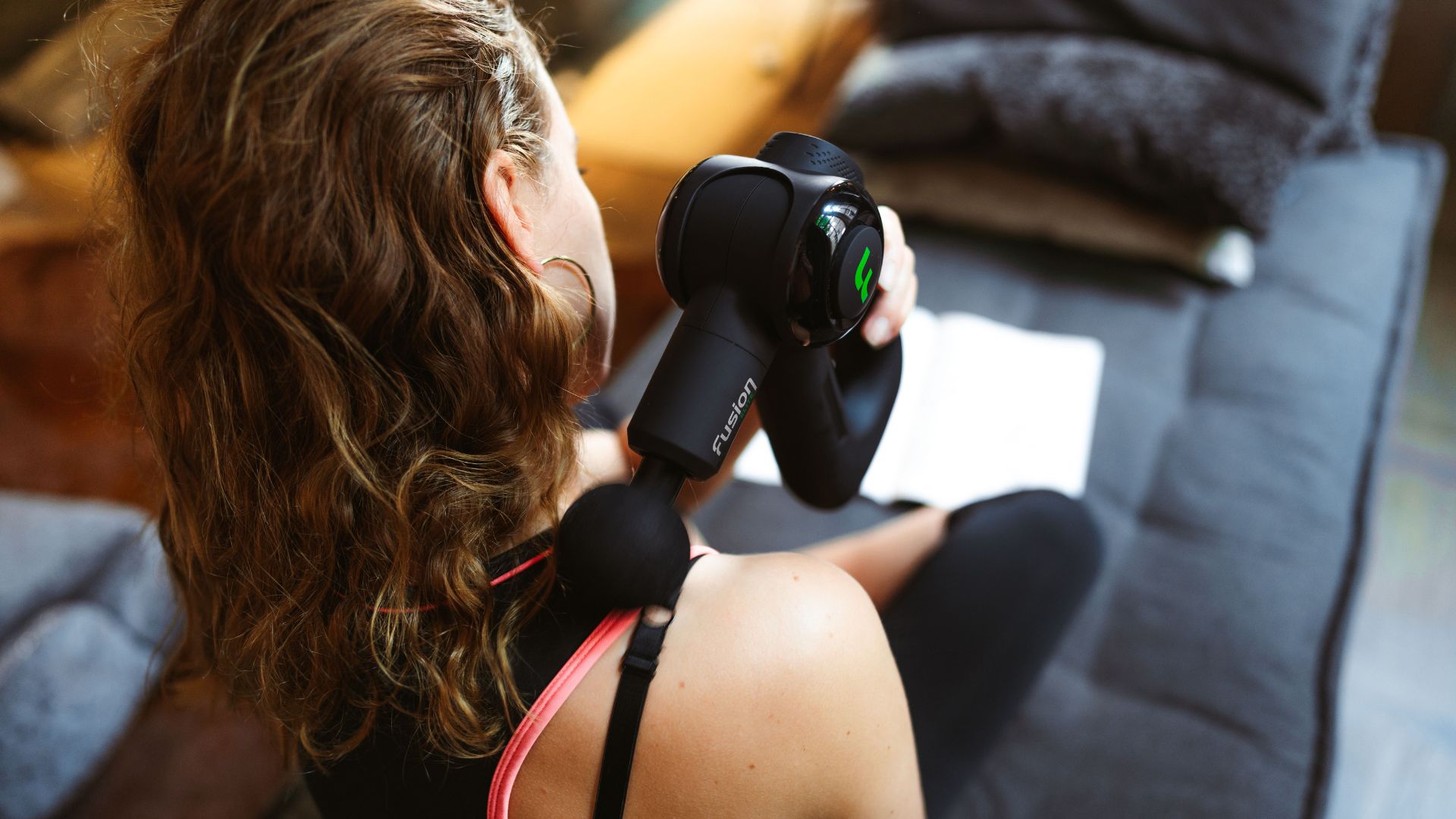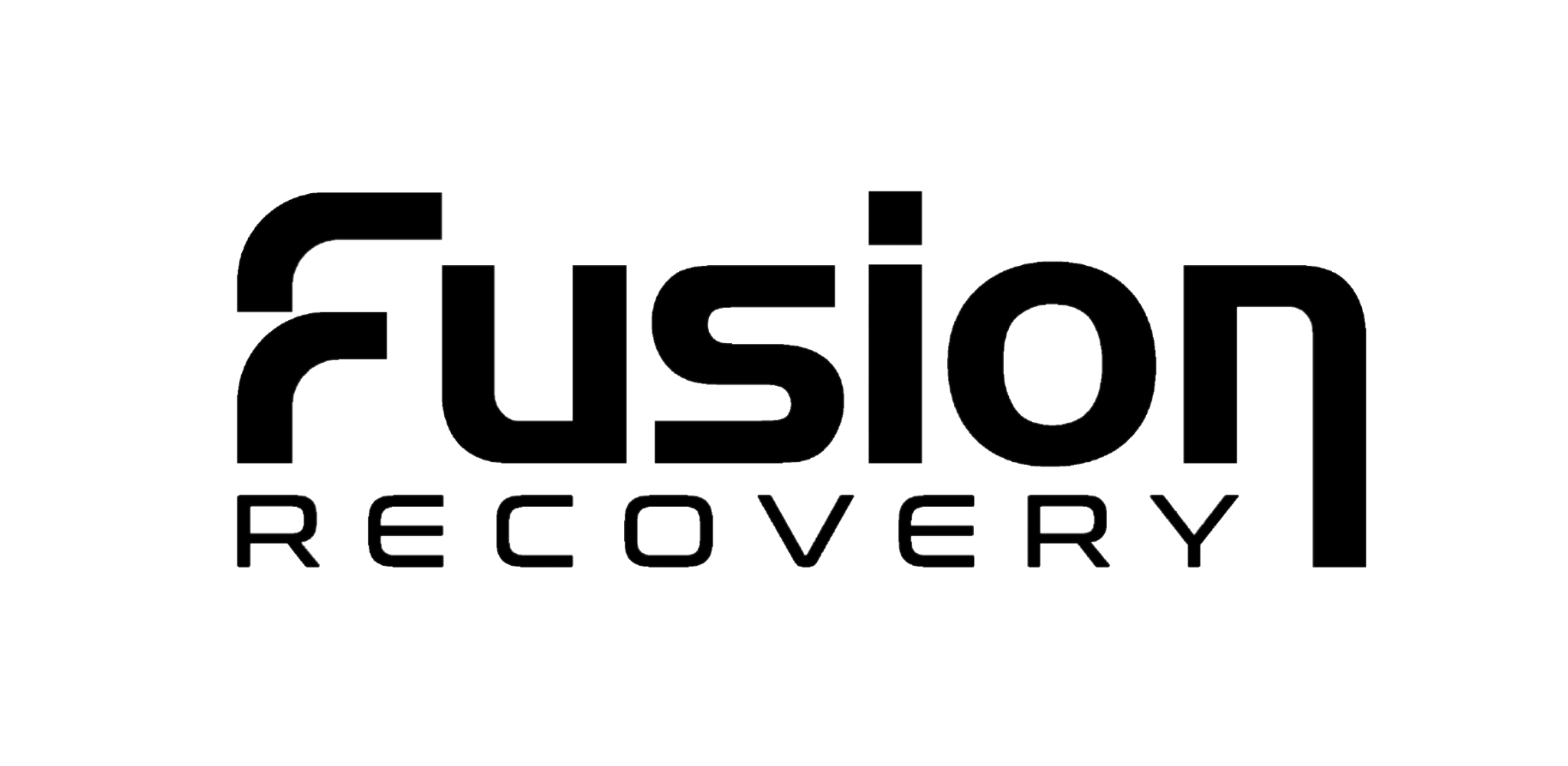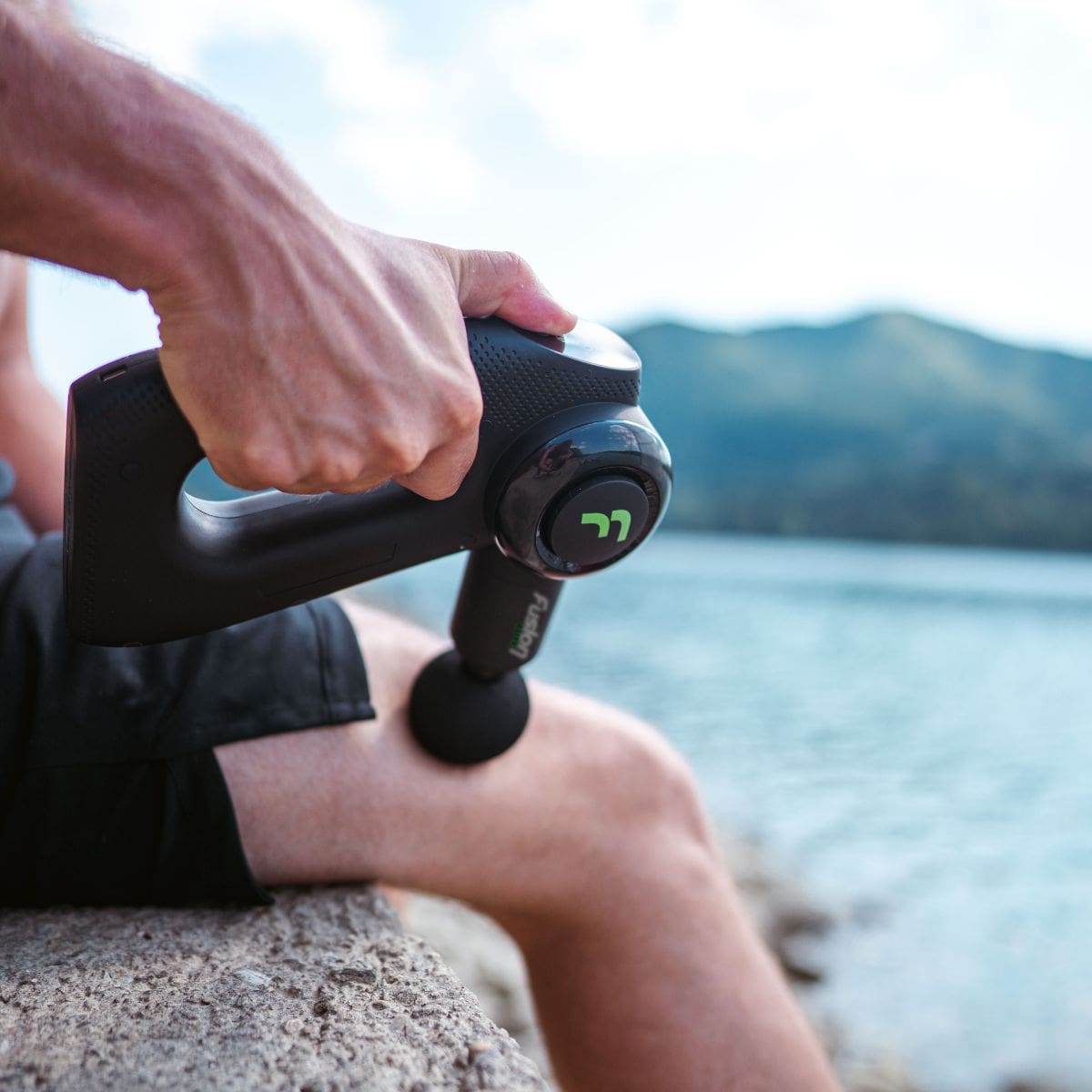Treating your body to trigger point therapy with a massage gun can be an incredibly effective way to relieve muscle tension and reduce soreness.
Known to render almost anyone unable to perform optimally, trigger points are knots of tightly contracted muscles that can result from overexertion, stress, or other causes. When left untreated, these knots cause severe pain that can travel to other parts of the body and worsen over time, making it difficult to perform everyday activities.
Trigger points are normally experienced in the neck, back, and shoulders. But they can also be found in other areas of the body, such as the hips, glutes, and even forearms.
If you find yourself dealing with trigger points, then you know how finding relief is essential to your quality of life. That’s why using a massage gun for trigger point therapy can be a great option to help you achieve relief from these knots and tension.
But what steps does one need to take when using a massage gun for trigger point therapy?
That's what you'll learn in this article.
From how to use a massage gun for trigger point therapy to the benefits it presents and more, you'll find all the information you need to start enjoying relief soon.
We’ll cover it all.
How to Perform Trigger Point Therapy With A Massage Gun
When it comes to using a massage gun for trigger point therapy, there are a few steps you'll need to take to ensure the best results.
Here's what you need to do:
Select the right massage gun attachment
Like with any massage tool, the first step in making use of a massage gun for trigger point therapy is to choose the right accessory.
In the case of massage guns, this usually means selecting the right attachment. Attachment heads are usually made of silicone, rubber, or plastic and come in different shapes to target almost any area of the body.
Depending on where you're looking to target, you'll want to select an attachment that is flexible enough to massage deep into the muscle without being overly aggressive. This could be something bulbous, like a round attachment for larger muscle groups, or something smaller and pointed for pinpointing tension in a specific area.
With the right attachment in place, move on to the next step in the process.
Choose the right speed level
As soon as you've chosen the right attachment, the next step is to select the right speed level.
Most massage guns come with a variety of speed settings, ranging from low to high. While the speed you choose depends on your own preference and the area you're massaging, as a rule of thumb, it's best to start slow.
This helps your muscles warm up and allows for more effective treatment, as well as reducing the risk of injury.
Find the trigger point and apply pressure

Once you’ve chosen the right attachment and speed setting for your trigger point therapy, it’s time to find the trigger point and apply pressure.
Trigger points can usually be felt as small, tight knots that cause localized pain or discomfort when pressed upon. To locate them, you can use your fingers and gently press around the area to find the source of tension.
Once you identify the trigger point, move the massage gun slowly over it and apply bursts of pressure while keeping the tip of the attachment on the knot for 10–20 seconds. During this time, you can move the device in circles or back and forth to help release the tension.
Move on to the next trigger point
Now that you've worked on one trigger point, it’s time to move onto the next spot.
Trigger points can be scattered throughout the body, so it may be necessary to treat several in one session. Every time you move to a new spot, make sure to switch up the attachment head and speed setting as needed.
Hold on for about 10–20 seconds, just as you did for the first trigger point, and then move on to the next point until you've worked through each one.
Trigger point therapy is an effective way to relieve tension and extreme pain, and making use of a massage gun can help you get the best results. With the right technique and a few simple steps, as we've outlined here, you'll be able to get back to feeling your best in no time.
Next, we'll dive into why performing trigger point therapy with a massage gun is an effective way to relieve tension and improve muscle health.
Benefits of Performing Trigger Point Therapy With a Massage Gun
From relieving tension to improving muscle health and more, the benefits of performing trigger point therapy with a massage gun are numerous.
Some of them include:
Reduced muscle tension
If you've ever dealt with tight body muscles, you know how uncomfortable and even painful they can be.
Trigger points are also responsible for referred pain, which is when pain is felt in a different part of the body than where it originated. Massage guns can help reduce muscle spasm by targeting and releasing these trigger points.
Here's how that works: when you place a massage gun on a trigger point, the vibrations from the device actually break up tension and knots in the muscle, helping you feel relief.
With regular use, massage guns can also help improve your body’s overall flexibility.
Improved circulation
Another benefit of trigger point therapy with a massage gun is improved circulation.
When your body's muscles get tight, the surrounding tissues can become constricted, leading to insufficient blood flow. Performing trigger point therapy with a massage gun helps relax tight muscles while stimulating the flow of blood throughout your body.
With improved blood flow, your muscles will be more oxygenated, allowing you to perform better during physical activity.
Better sleep

While you may be wondering how trigger point therapy plays into your sleep routine, the answer is quite simple.
If you suffer from tight muscles and chronic trigger point pain, it can make it difficult to fall asleep and stay asleep. Making use of a massage gun on trigger point areas can help relieve any tension and intense pain that's preventing you from getting a good night's rest.
With better sleep and more relaxed muscles, you'll be able to wake up feeling more refreshed and energized, making it easier to tackle the day.
Better flexibility
Next on our list is improved flexibility.
Trigger points are notorious for causing tightness and limited range of motion in our muscles.
With tight muscles, this can make it difficult to perform everyday activities like reaching for something on the top shelf or even bending down to tie your shoes. Using a massage gun on trigger points can help to loosen tight muscles and improve flexibility, allowing you to move with ease.
This way, you can get back to doing the activities you enjoy without feeling limited in any way, for a better quality of life.
Improved posture
Having a hard time sitting up straight or standing tall?
Trigger points are often responsible for poor posture as they can cause pain and tension in the neck, back, and even your shoulder area. Taking time to massage these areas with a massage gun can help reduce tension and pain, making it easier to sit or stand up straight.
Not only will this help you look better, but it will also improve your overall health by reducing the strain on sore muscles and joints that comes from poor posture. This ensures you get the most out of your daily activities without having to worry about any pain or tension.
These are just some of the many benefits that come with performing trigger point therapy with a massage gun.
Whether you're looking to improve your muscle health or just want to relax and reduce tension, a percussive massage gun can be an invaluable tool in achieving overall wellness. Just ensure to follow the steps we've outlined before for a safe and effective massage session.
Now let's dive into just how you can maximize these benefits for a better quality of life.
What to Do Before and After Performing Trigger Point Therapy With a Massage Gun
While the benefits of using a massage gun for trigger point therapy are great, there are certain steps you can take to maximize the results.
Here's what you can do before and after your massage session:
Before
Getting ready for trigger point therapy isn't just about getting your massage gun out and ready. Here's what you should do before your session:
Warm up your body's muscles

A primary way you can maximize the benefits of trigger point therapy is by warming up your muscles prior to massage.
This can be done by doing some light stretches or even taking a warm bath, as this helps to loosen tight muscles and improve circulation in the area you're targeting. Simple, light stretches found to be good for this include shoulder rolls, arm circles, and toe touches.
If you're opting for a bath before your massage, make sure the water is at a comfortable temperature, neither too hot nor too cold. You can also add some essential oils, like lavender, to your bath for an extra relaxing effect.
Stay hydrated
With your body's muscles all warmed up, staying hydrated is another step you can take to maximize the benefits of trigger point therapy.
Staying hydrated helps keep your muscles properly nourished for repair and recovery, as nutrients are delivered more quickly to areas that need them. To ensure proper levels of hydration, aim to drink at least eight glasses of water a day.
You can also opt for herbal teas like chamomile or green tea for an extra relaxing effect.
Wear comfortable clothing
While it may seem like a small detail, wearing comfortable clothing before your massage session can make a big difference in the overall experience.
Clothing that is too tight and restrictive can limit the wide range of motion in certain areas, making it difficult to perform certain stretches or even access trigger points you may be targeting.
Loose-fitting clothing that allows for a full range of motion is ideal for trigger point therapy as it gives you the freedom to move around properly. This includes items like a tank top or shorts, as well as yoga pants and other workout clothing.
After
Once you've completed your massage session, there are steps you can take to maximize the benefits of trigger point therapy.
Here's what you should do after:
Take time to rest
Finding relief and relaxation in massage can be a great way to end your day, but resting afterwards is also key.
After you've had your massage session, it's important to get some rest so your body can recover and repair itself. This can be achieved by getting a good night's sleep, taking breaks throughout the day, and avoiding activities that require too much physical effort.
This way, your body's muscles can be properly restored for a better quality of life.
Eat well
Eating well is an important part of maximizing the benefits of trigger point therapy.
Eating healthy meals that are full of vitamins, minerals, and other nutrients can help keep your muscles nourished and energized throughout your massage session. Opt for foods like lean meats, fruits, vegetables, whole grains, nuts, and seeds for a balanced meal.
What's more, you can also increase your protein intake by consuming plant-based proteins like beans and legumes.
Rehydrate

While staying hydrated is important before your massage session, it's also important to remember to stay hydrated afterwards.
Drinking water not only helps to stimulate muscle tissue repair and recovery, but it also helps to flush out toxins from the human body. This ensures your cells are functioning properly and that any inflammation is kept at bay.
So, aim to drink at least 8 glasses of water a day and stay hydrated for maximum trigger point therapy benefits!
Frequently Asked Questions
After going through the steps of trigger point therapy with a massage gun, you may still have some questions about the process.
Check out some answers we’ve compiled for you.
How often should I perform trigger point therapy with a massage gun?
Treating your body to a massage gun session is an excellent way to manage referral pain and improve your overall wellbeing.
However, it's important to note that the frequency of usage should be determined by how many trigger points you have to work on. If you're working on a single trigger point, you can use your massage gun 2-3 times a week, but if you're working on multiple trigger points, you can use it every day.
Just make sure that you're taking regular breaks and not pushing yourself too hard, as this can cause more harm than good.
Besides trigger point therapy, are there other therapies I can perform with a massage gun?
While trigger point therapy is one of the main uses for massage guns, there are other benefits you can get from using a massage gun.
For example, your massage gun can be used for sports and deep tissue massages to improve circulation and muscle performance. It can also be used for relaxation purposes, such as taking out stress or tension knots in the body.
And let's not forget about percussive therapy, which is a technique that uses repetitive pulses to promote healing and mobility. This is, in fact, the primary use of massage guns, as percussion therapy presents an excellent way to get relief from chronic pain or aches.
Whichever massage technique you choose to use, make sure to follow the right technique and apply the right amount of pressure to the areas you're working on.
What precautions should I keep in mind when performing trigger point therapy with a massage gun?
As with any massage tool, it's important to always keep safety in mind when using a massage gun for trigger point therapy.
This starts with using the right level of intensity for your body, as pushing too hard can cause more harm than good. Also, make sure to avoid areas of the body that are inflamed, as well as areas with varicose veins or skin conditions.
Other precautions to keep in mind include avoiding using the massage gun over bony regions of the body like your spine and hips, as this can cause discomfort. This way, you can ensure that your massage gun session is as effective and comfortable as possible.
Are there any risks or side effects to performing trigger point therapy with a massage gun?
Yes, there are some risks and side effects associated with performing trigger point therapy with a massage gun.
This includes the potential for bruising or skin irritation in the area of treatment, as well as the risk of over-treating an area of muscle tension. Other potential risks include the risk of nerve damage or tissue inflammation, which can occur if too much pressure is applied.
That's why it's important to always follow the instructions we've outlined here to ensure your massage gun session is as safe and effective as possible.
Conclusion
Now that you know how to perform trigger point therapy with a massage gun, you can get started on relieving your muscle pain for a better quality of life.
Just make sure to always follow the instructions we've outlined here to ensure your massage gun session is as safe and effective as possible. This starts with choosing the right interchangeable heads for your massage gun, setting the right intensity level, and massaging trigger points with the right amount of pressure.
By following these instructions, you can get the most out of your massage gun and enjoy the many benefits that come with treating your trigger points. This includes reduced muscle tension, improved circulation, better sleep, and even improved posture.
With the right level of care and attention, you can get the most out of your therapy and enjoy a healthier lifestyle. Reach out to us if you have any questions regarding how to use a massage gun for trigger point therapy.
We'll be more than happy to provide you with the answers you need.




